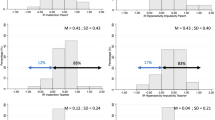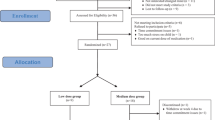Abstract
The efficacy and side effects of buspirone compared with methylphenidate (MPH) in the treatment of children with attention-deficit/hyperactivity disorder (ADHD). A total of 34 children with ADHD as defined by DSM-IV-TR were randomized to buspirone or methylphenidate dosed on weight-adjusted basis at buspirone (0.5 mg/kg/day) and methylphenidate (0.3–1 mg/kg/day) for a 6-week double-blind clinical trial. The principle measures of outcome were the teacher and parent ADHD Rating Scale. The side effects were assessed by the special side effect checklist of each drug. In both groups, the scores of teacher and parent ADHD Rating Scale significantly declined on the 6th week as compared to baseline (p = 0.001). These effects were observed in the subscales too. No significant differences were observed between the two protocols on the total scores of parent and teacher ADHD Rating Scale, but methylphenidate was superior to buspirone in decreasing the symptoms of inattention. The side effects of buspirone were mild and rare in comparison with MPH. Buspirone has a favorable side-effects profile. It also has clinically and statistically significant impacts on improving the ADHD symptoms in children. These preliminary findings of the efficacy of buspirone in children with ADHD need large and cross-over studies.


Similar content being viewed by others
Abbreviations
- ADHD:
-
Attention deficit hyperactivity disorder
- MPH:
-
Methylphenidate
References
Rowland AS, Lesesne CA, Abramowitz AJ (2002) The epidemiology of attention-deficit/hyperactivity disorder (ADHD): a public health view. Ment Retard Dev Disabil Res Rev 8(3):162–170
Kessler RC, Adler LA, Barkley R, Biederman J, Conners CK, Faraone SV et al (2005) Patterns and predictors of attention-deficit/hyperactivity disorder persistence into adulthood: results from the national comorbidity survey replication. Biol Psychiatry 57:1442–1451
Cook EH Jr, Stein MA, Krasowski MD, Cox NJ, Olkon DM, Kieffer JE et al (1995) Association of attention-deficit disorder and the dopamine transporter gene. Am J Hum Genet 56:993–998
Raskin LA, Shaywitz BA, Anderson GM, Cohen DJ, Teicher MH, Linakis J (1983) Differential effects of selective dopamine, norepinephrine or catecholamine depletion on activity and learning in the developing rat. Pharmacol Biochem Behav 19:743–749
Shaywitz BA, Teicher MH, Cohen DJ, Anderson GM, Young JG, Levitt P (1984) Dopaminergic but not noradrenergic mediation of hyperactivity and performance deficits in the developing rat pup. Psychopharmacology (Berl) 82:73–77
Shekim WO, Dekirmenjian H, Chapel JL (1979) Urinary MHPG excretion in minimal brain dysfunction and its modification by d-amphetamine. Am J Psychiatry 136:667–671
Gillberg C, Melander H, von Knorring AL, Janols LO, Thernlund G, Hagglof B et al (1997) Long-term stimulant treatment of children with attention-deficit hyperactivity disorder symptoms. A randomized, double-blind, placebo-controlled trial. Arch Gen Psychiatry 54:857–864
Safer DJ (1997) Changing patterns of psychotropic medications prescribed by child psychiatrists in the 1990 s. J Child Adolesc Psychopharmacol 7:267–274
Wilens TE, Biederman J (1992) The stimulants. Psychiatr Clin North Am 15:191–222
Arnold LE (2000) Methyiphenidate vs. amphetamine: comparative review. J Atten Disord 3:200–211
Findling RL, Schwartz MA, Flannery DJ, Manos MJ (1996) Venlafaxine in adults with attention-deficit/hyperactivity disorder: an open clinical trial. J Clin Psychiatry 57:184–189
Klein RG, Landa B, Mattes JA, Klein DF (1988) Methylphenidate and growth in hyperactive children. A controlled withdrawal study. Arch Gen Psychiatry 45:1127–1130
Pataki CS, Carlson GA, Kelly KL, Rapport MD, Biancaniello TM (1993) Side effects of methylphenidate and desipramine alone and in combination in children. J Am Acad Child Adolesc Psychiatry 32:1065–1072
Kehoe WA (2001) Treatment of attention deficit hyperactivity disorder in children. Ann Pharmacother 35:1130–1134
Prince JB, Wilens TE, Biederman J, Spencer TJ, Millstein R, Polisner DA et al (2000) A controlled study of nortriptyline in children and adolescents with attention deficit hyperactivity disorder. J Child Adolesc Psychopharmacol 10:193–204
Temple DL Jr, Yevich JP, New JS (1982) Buspirone: chemical profile of a new class of anxioselective agents. J Clin Psychiatry 43:4–10
Taylor D, Hyslop D (1991) Chronic administration of buspirone down-regulates 5-HT2 receptor binding sites. Drug Dev Res 24:93–105
Tunnicliff G, Brokaw JJ, Hausz JA, Matheson GK, White GW (1992) Influence of repeated treatment with buspirone on central 5-hydroxytryptamine and dopamine synthesis. Neuropharmacology 31:991–995
Castillo C, Ibarra M, Marquez AJ, Villalobos-Molina R, Hong E (1993) Vascular effects of ipsapirone are related with subtypes of alpha 1-adrenergic receptors. Arch Med Res 24:161–168
Castillo C, Ibarra M, Marquez JA, Villalobos-Molina R, Hong E (1993) Pharmacological evidence for interactions between 5-HT1A receptor agonists and subtypes of alpha 1-adrenoceptors on rabbit aorta. Eur J Pharmacol 241:141–148
Sanghera MK, McMillen BA, German DC (1982) Buspirone, a non-benzodiazepine anxiolytic, increases locus coeruleus noradrenergic neuronal activity. Eur J Pharmacol 86:107–110
Malhotra S, Santosh PJ (1998) An open clinical trial of buspirone in children with attention-deficit/hyperactivity disorder. J Am Acad Child Adolesc Psychiatry 37:364–371
Niederhofer H (2003) An open trial of buspirone in the treatment of attention-deficit disorder. Hum Psychopharmacol 18:489–492
Neppe V, Young Z (2003) Buspirone as a new treatment for attention deficit disorder and aggression in children and adolescents. Austral J Psychopharmacol 10:47–56
Gross MD (1995) Buspirone in ADHD with ODD. J Am Acad Child Adoles Psychiatry 34:1260
DuPaul G (1991) Parent and teacher ratings of ADHD symptoms: psychometric properties in a community-based sample. J Clin Child Psychol 20:245–253
Park E, Cho M, Ki C (2009) Correct use of repeated-measures analysis of variance. Korean J Lab Med 29:1–9
Neppe V (1990) Innovative psychopharmacotherapy. Raven Press, New York
Neppe V (1999) Cry the beloved mind: a voyage of hope. Brainquest Press DBA Brainvoyage.com, Seattle
Acknowledgments
This work was supported in part by the grant from the Behavioral Sciences Research Center of Shahid Beheshti University of Medical Sciences (Tehran, Iran). The authors express their gratitude to Ali Fakhrabadi and Ebrahim Parvin for editing the manuscript.
Author information
Authors and Affiliations
Corresponding author
Rights and permissions
About this article
Cite this article
Davari-Ashtiani, R., Eslami Shahrbabaki, M., Razjouyan, K. et al. Buspirone Versus Methylphenidate in the Treatment of Attention Deficit Hyperactivity Disorder: A Double-Blind and Randomized Trial. Child Psychiatry Hum Dev 41, 641–648 (2010). https://doi.org/10.1007/s10578-010-0193-2
Published:
Issue Date:
DOI: https://doi.org/10.1007/s10578-010-0193-2




